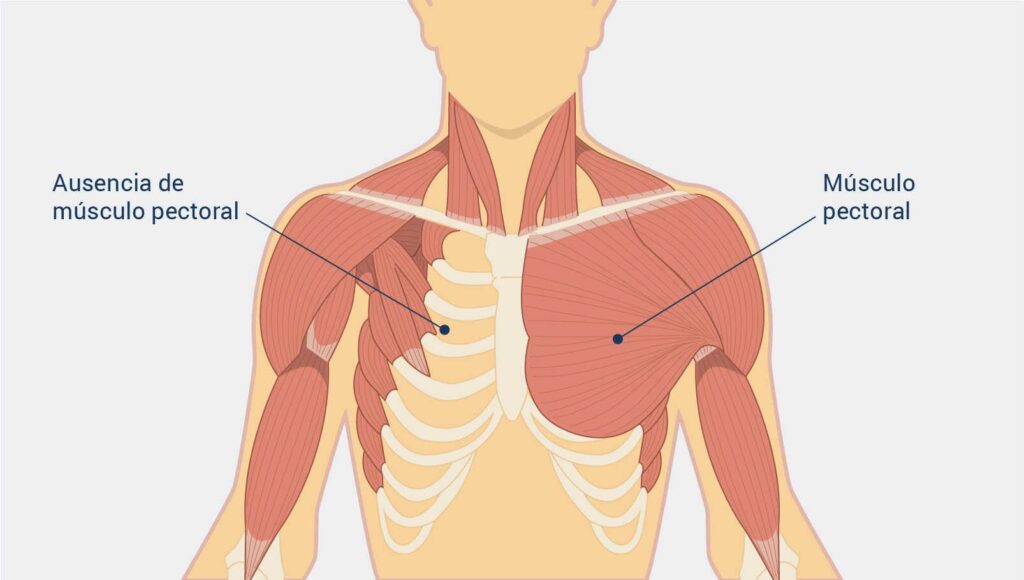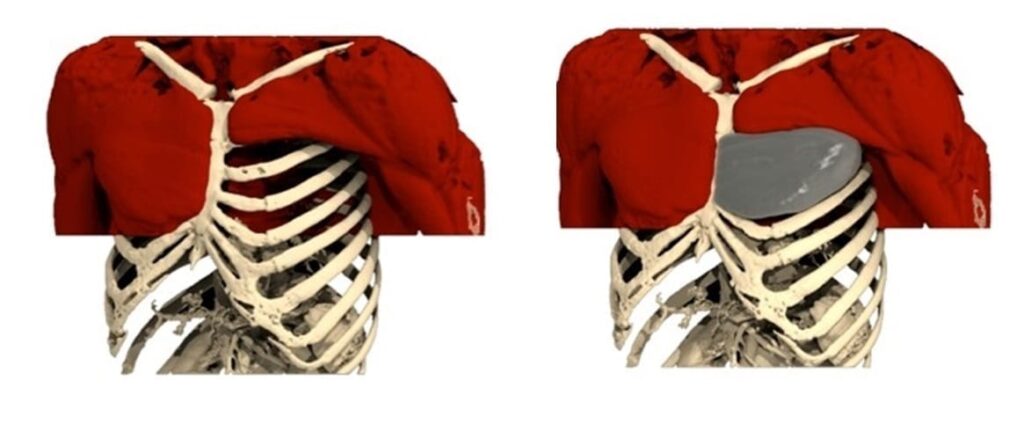
Poland syndrome, also called Poland syndrome, Poland syndactyly, Poland sequence or Poland anomaly, is a rare birth defect characterized by the absence (hypoplasia) or underdevelopment (agenesis) of the pectoralis major muscle on one side of the body.
Sometimes accompanied by malformations of the hand: webbing (fusion) of the fingers(cutaneous syndactyly) of the hand on the same side, mainly common on the right side of the body, in 70%, it is more frequent in males than in females in a ratio of 75%-25%.
In 1841, Alfred Poland, a 19-year-old medical student at Guy’s Hospital (London) published the classic description of the syndrome that bears his name. It affects one in 20,000/32,000 live births.
Poland syndrome is sometimes accompanied by:
In 15% of cases Poland syndrome coexists with Moebius syndrome, which is characterized by facial paralysis, inability to smile or frown or move the eyes from side to side.
The cause of Poland syndrome is unknown. However, an interruption of the embryonic blood supply to the arteries below the clavicle (subclavian arteries) around the sixth week of management (46th day of embryonic development) is the prevailing theory. This theory is reinforced by the fact that patients present, in some cases, vascular alterations and Klippel Trenaunay syndrome.
These deficiencies are largely cosmetic, with the most common (simple) form presenting as unilateral absence of the sternocostal head of the pectoralis major muscle. The deformity can also be complex, with ipsilateral absence of ribs, axillary fold, and distortions of the hemithorax. The complex may also incorporate a variety of ipsilateral trunk defects and upper extremity defects, including agenesis of the anterior portions of ribs two to five, sternal deformity and absence of the latissimus dorsi, serratus, external and internal abdominal obliques. Breast tissues may be small or absent and the areola-nipple complex may be small, slightly pigmented, and displaced toward the axilla.

For women, the simplest cases can be satisfactorily treated with a breast prosthesis. However, this option can accentuate the subclavicular sagging and, because of the natural tightness of the parasternal tissues, the implant can migrate into this space. This results in malposition. Adjuvant breast implant treatments may include a silicone implant that repairs the thoracic contour and customized with CT, fat grafting (lipofilling), a TRAM or DIEP flap, and/or a latissimus muscle transfer, all of which can provide shape and volume to the deficient upper wall.
Fat grafting is also a good option to disguise the contour of the implant and achieve a better symmetry. Another option is the transfer of the latissimus dorsi muscle, a technique used when we need to conceal the prosthesis or the expander, having the great advantage of giving an adequate shape to the axillary area. The disadvantage is that the sacrificed muscle can atrophy in the long run, losing volume.
In men, the best technique is to use a pectoral implant. Currently we use custom-made implants, which are created from a Computerized Axial Tomography (CAT).
We are a Spanish reference center in reconstruction with custom-made prostheses. We have received theoretical and practical training on the computerized construction of 3D implants and the different intervention techniques (pectus excavatum, Poland’s syndrome or other muscle deficiencies).

Fat grafting can be used to disguise unavoidable implant edges that can be seen subcutaneously.
In patients with excess fat in the abdomen and healthy chest, autologous fat is obtained from these areas, thus improving their appearance by eliminating excess tissue, using this fat to fill the missing area.
In complex cases where there are missing ribs, the defect is treated with a synthetic mesh and implants are not used because there is no firm bottom. In these cases autologous tissues are the option of choice for reconstruction.
EXCELENTETrustindex verifica que la fuente original de la reseña sea Google. Maravillosa experiencia con la Doctora Salvador!!!Trustindex verifica que la fuente original de la reseña sea Google. Estic encantada! Son els millors!Trustindex verifica que la fuente original de la reseña sea Google. Muy profesionales. El trato es atento y cercano. Los resultados óptimos. He quedado muy satisfecho, los recomiendo totalmente.Trustindex verifica que la fuente original de la reseña sea Google. Es la mejor clínica. Yo fue operado por el Dr. Benito. Durante mucho tiempo elegí una clínica y un médico, dudé. Pero tuve mucha suerte, ¡caí en manos de oro! Estoy muy contenta con el resultado inmejorable. El doctor es un especialista muy atento y elegante. Todo el personal de la clínica es muy agradable. 😊🌟✨💫Trustindex verifica que la fuente original de la reseña sea Google. Muy buena clínica, la doctora Salvador explica todo de manera que sabes que estas en buenas manos.Trustindex verifica que la fuente original de la reseña sea Google. Espectacular resultado gracias al dr.benito y a su equipo🥰Trustindex verifica que la fuente original de la reseña sea Google. Hace más de 15 años que confío en el doctor Jesús Benito. Un gran cirujano y una persona encantadora. Gracias por todos los cuidados !!!!Trustindex verifica que la fuente original de la reseña sea Google. Muy agradecido al Dr Benito por la confianza que se gana y que te ayuda a tomar decisiones. Muy satisfecho con su profesionalidad y los resultados. Y muy contento con su equipo por lo cómodo y fácil que te hacen todo.
The surgery is performed under general anesthesia. After surgery, it is common for the patient to experience some pain and discomfort in the incision area, but this can usually be controlled with pain medication and other postoperative care measures.
Every patient is different and the experience of pain may vary depending on factors such as individual pain tolerance and the type of surgery performed. As a surgeon, we will work closely with the patient and the healthcare team to minimize any discomfort during and after the procedure.
It is important for patients to understand that surgery for Poland’s syndrome is an invasive procedure that requires adequate recovery time. Ensuring that the patient is comfortable and has a comprehensive postoperative care plan is an important part of the treatment process.
Like any other surgery, there are some risks associated with the procedure. Some of the most common risks include bruising, infection, excessive bleeding, noticeable scarring or even complications with the anesthesia used during surgery.
However, with a qualified and experienced surgeon, the risks are minimized and the benefits of surgery for Poland syndrome far outweigh the potential risks. It is important to discuss any concerns you have with your surgeon and follow aftercare instructions carefully to help minimize risks and ensure a quick and smooth recovery.